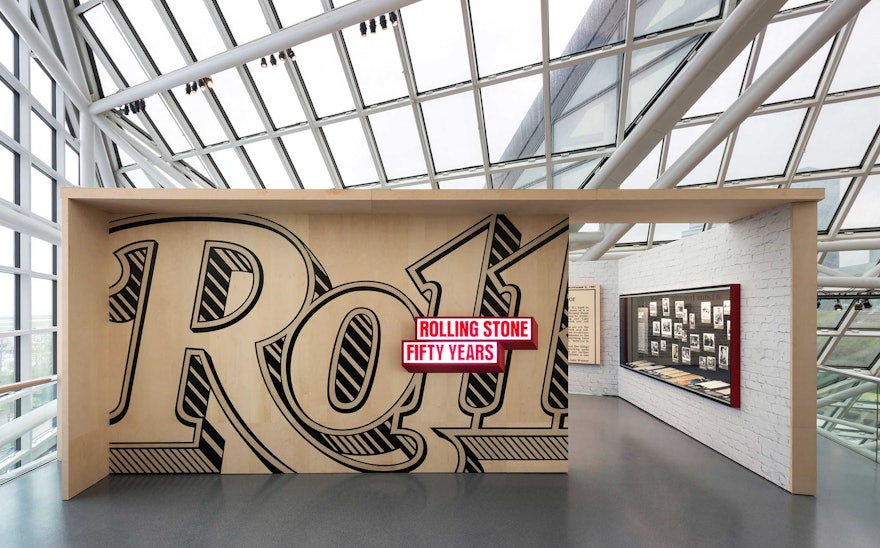Rolling Stone magazine celebrates its 50th anniversary this year as one of the world’s leading pop culture publications, covering music, politics, film and more through five decades of enormous change. Pentagram has designed Rolling Stone: 50 Years, an exhibition at the Rock and Roll Hall of Fame and Museum that explores the history and legacy of the groundbreaking magazine. The show draws upon Rolling Stone’s vast archives to tell its story through original artifacts, manuscripts and photographs, as well as interviews with many of the people featured within its pages and on its iconic covers.
The designers worked closely on the design of the exhibition with Jann Wenner, Rolling Stone’s renowned co-founder, publisher and editor-in-chief. Spread across the top three levels of the museum, the show presents a series of environments inspired by the structure of the magazine itself. The iconographic Rolling Stone logo is used as a framework to tie it all together, with the various sections identified by large-scale typography inspired by 1977 dimensional version of the masthead (originally drawn by Jim Parkinson).
The exhibition begins in the fourth floor atrium with a recreation of Rolling Stone’s first office at 746 Brannan in San Francisco, complete with several original furnishings. Era-defining images by Annie Leibovitz and Baron Wolman, the magazine’s original staff photographers, are displayed, as is Wenner’s original letter from the editor, which lays out the mission of the publication to be an epicenter of music, popular culture and politics: “Rolling Stone is not just about music, but also about the things and attitudes that the music embraces.”
The exhibition’s second level immerses visitors in the Rolling Stone narrative in a series of galleries inspired by the magazine’s signature sections and departments. The floor is outlined in a Table of Contents before proceeding through the front-of-book Random Notes and Short Cuts and into the Features well. Each area is packed with rarely seen notes, letters, transcripts and photographs, reproductions of pages and layouts, and video and audio clips.
The Letters to the Editor section spotlights missives from John Lennon, Sting, Allen Ginsberg, Grace Slick, Paul McCartney and Charles Manson. At the middle of the gallery, a portrait wall features photographs and illustrations by many of the great visual artists who have contributed to the magazine, hung on the circular perimeter of the central staircase, which has been painted the bright Rolling Stone red.
Features looks at the magazine’s most famous journalistic moments, with draft manuscripts and excerpts of essays and stories by writers such as Tom Wolfe and Hunter S. Thompson, as well as articles that the magazine broke that resonated in the wider culture, like Sean Penn’s interview with El Chapo.
A special section chronicles the famous Rolling Stone Interview, with in-depth profiles of significant artists and newsmakers including David Bowie, John Lennon, Madonna, and more. Visitors can watch video conversations with subjects such as President Barack Obama, Lady Gaga and Bono and listen to audio of others via interactive screens.
Another display surveys the magazine’s best and most interesting album reviews, including some controversial takes that ultimately helped identify or predict a record as a popular hit or artistic landmark, and a few that eventually proved wildly inaccurate.
The final gallery, a nearly 30-foot high volume, is located at the apex of the museum’s pyramid, accessed by a spiral staircase. The space is dedicated to a survey of the most iconic Rolling Stone covers, displayed in vastly enlarged scale on 10-foot tall lightboxes. Above the covers, projected on all four sides of the gallery, is a sequence of interviews conducted for the exhibition, featuring Mick Jagger, Taylor Swift, and Lenny Kravitz, reflecting on their experience of being on the cover, and the role of the magazine in pop culture.

